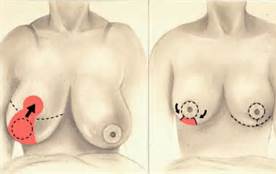Breast Reduction: Ranks High in Patient Satisfaction
 Just as some women may experience a decrease in breast size over time, some will notice an increase in breast size, others simply want a change. When a woman is uncomfortable with having too much breast tissue, there are several options to correct this condition. A dramatic increase in size may have resulted due to an increase in overall weight gain or a pronounced sagging of the breast tissue. As we’ve discussed in earlier posts, overly large breasts may cause physical discomfort, including symptoms like neck pain, back pain, shoulder grooving and irritation beneath the breasts. Patients routinely turn to breast reduction or breast lift surgery to reduce their symptoms, along with their breast size and or position. Patient satisfaction rates are particularly high for this cosmetic surgery. Reducing breast size can be done with direct surgical removal of breast tissue or by using liposuction. Liposuction is effective only when there is a significant amount of fat in the breasts. Liposuction does not adjust nipple position, which requires removing and re-positioning the nipple.
Just as some women may experience a decrease in breast size over time, some will notice an increase in breast size, others simply want a change. When a woman is uncomfortable with having too much breast tissue, there are several options to correct this condition. A dramatic increase in size may have resulted due to an increase in overall weight gain or a pronounced sagging of the breast tissue. As we’ve discussed in earlier posts, overly large breasts may cause physical discomfort, including symptoms like neck pain, back pain, shoulder grooving and irritation beneath the breasts. Patients routinely turn to breast reduction or breast lift surgery to reduce their symptoms, along with their breast size and or position. Patient satisfaction rates are particularly high for this cosmetic surgery. Reducing breast size can be done with direct surgical removal of breast tissue or by using liposuction. Liposuction is effective only when there is a significant amount of fat in the breasts. Liposuction does not adjust nipple position, which requires removing and re-positioning the nipple.
Traditional breast reduction surgery reduces breast size through excision of breast tissue, while repositioning the nipple and areola (pigmented skin around the nipple). The size of the areola can also be reduced. Breast reduction scars, which are similar to breast lift surgery, are placed around the nipple and beneath the breast as well. Scars will be less noticeable as they continue to heal. I recommend any breast tissue that is removed should be sent for examination by a pathologist. This laboratory examination includes a visualization under a microscope after tissue staining, to determine the presence of conditions or abnormalities which might increase chances of breast cancer. On rare occasions, breast cancer is diagnosed this way.
Our patients choose of their desired final breast size, based on decisions made during our office consultation, unless insurance is being considered. A range of implant “sizers” are helpful in this regard. The appropriate time to schedule reduction surgery following pregnancy is determined by normal involution of breast tissue and the end to breast-feeding. Generally this takes six months to a year after delivery or three months after ending breast-feeding. There is a possibility that some women will not be able to breast feed again after breast reduction surgery. Therefore, if breast-feeding is an important consideration, we advise our patients to postpone breast reduction surgery until they are finished having children. According to statistics provided by the American Society of Plastic Surgeons (ASPS), more than 120,000 patients have chosen breast reduction/ lift surgery last year.
